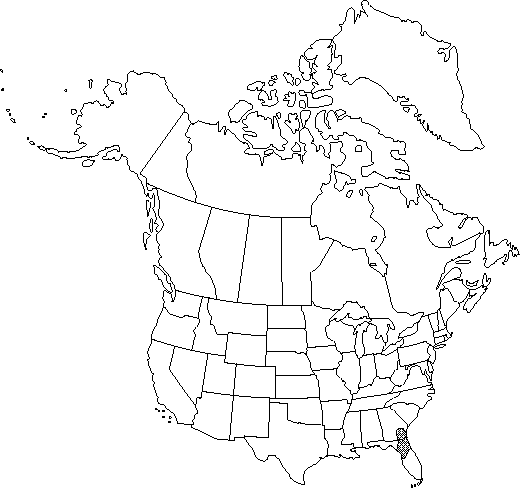Difference between revisions of "Asimina incana"
J. Bot. 65: 69. 1927.
FNA>Volume Importer |
imported>Volume Importer |
||
| (6 intermediate revisions by 2 users not shown) | |||
| Line 9: | Line 9: | ||
|common_names=Polecat-bush;flag-pawpaw | |common_names=Polecat-bush;flag-pawpaw | ||
|special_status={{Treatment/ID/Special_status | |special_status={{Treatment/ID/Special_status | ||
| + | |code=W1 | ||
| + | |label= | ||
| + | }}{{Treatment/ID/Special_status | ||
|code=E | |code=E | ||
|label=Endemic | |label=Endemic | ||
| − | |||
| − | |||
| − | |||
}} | }} | ||
| − | |basionyms={{Treatment/ID/ | + | |basionyms={{Treatment/ID/Basionym |
|name=Annona incana | |name=Annona incana | ||
|authority=W. Bartram | |authority=W. Bartram | ||
| + | |rank=species | ||
| + | |publication_title=Travels Carolina, | ||
| + | |publication_place=171. 1791 (as incarna) | ||
}} | }} | ||
|synonyms={{Treatment/ID/Synonym | |synonyms={{Treatment/ID/Synonym | ||
|name=Annona speciosa | |name=Annona speciosa | ||
|authority=Nash | |authority=Nash | ||
| − | }}{{Treatment/ID/Synonym | + | |rank=species |
| + | }} {{Treatment/ID/Synonym | ||
|name=Pityothamnus incanus | |name=Pityothamnus incanus | ||
|authority=(W. Bartram) Small | |authority=(W. Bartram) Small | ||
| + | |rank=species | ||
}} | }} | ||
|hierarchy=Annonaceae;Asimina;Asimina incana | |hierarchy=Annonaceae;Asimina;Asimina incana | ||
| Line 40: | Line 45: | ||
|elevation=0-150 m | |elevation=0-150 m | ||
|distribution=Fla.;Ga. | |distribution=Fla.;Ga. | ||
| − | |discussion=<p>Asimina incana hybridizes with A. longifolia and A. reticulata, and possibly A. pygmaea.</p> | + | |discussion=<p><i>Asimina incana</i> hybridizes with <i>A. longifolia</i> and <i>A. reticulata</i>, and possibly <i>A. pygmaea</i>.</p> |
|tables= | |tables= | ||
|references= | |references= | ||
| Line 49: | Line 54: | ||
-->{{#Taxon: | -->{{#Taxon: | ||
name=Asimina incana | name=Asimina incana | ||
| − | |||
|authority=(W. Bartram) Exell | |authority=(W. Bartram) Exell | ||
|rank=species | |rank=species | ||
| Line 63: | Line 67: | ||
|publication title=J. Bot. | |publication title=J. Bot. | ||
|publication year=1927 | |publication year=1927 | ||
| − | |special status=Endemic | + | |special status=W1;Endemic |
| − | |source xml=https:// | + | |source xml=https://bitbucket.org/aafc-mbb/fna-data-curation/src/2e0870ddd59836b60bcf96646a41e87ea5a5943a/coarse_grained_fna_xml/V3/V3_1159.xml |
|genus=Asimina | |genus=Asimina | ||
|species=Asimina incana | |species=Asimina incana | ||
Latest revision as of 21:46, 5 November 2020
Shrubs, to 1.5 m. Branches copious, stiff; shoots red-brown or tan with dense, pale tomentum, maturing tomentose only distally. Leaves: petiole 2-6 mm. Leaf blade oblong to obovate, 5-8c m, leathery, base round to abruptly broadly cuneate, margins obscurely revolute, apex obtuse to rounded, often notched; surfaces abaxially and adaxially densely tomentose with pale blond or tan hairs, becoming moderately or weakly so. Inflorescences from previous year's growth; peduncle 2-3.5 cm, pale-tomentous; bracteoles 1-2, basal, usually ovate-triangular, rarely more than 2-3 mm, hairy. Flowers 1-4 per node, fragrant, large; sepals triangular-deltate, 8-12 mm, abaxially pale-tomentose; outer petals 3(-4), white or cream, ovate to oblong or obovate, 3.5-7 cm, abaxially pale-puberulent, veins impressed adaxially; inner petals yellow-white, lance-hastate, 1/3-1/2 length of outer petals, base saccate, adaxially deep yellow corrugate zone; pistils 3-5(-11). Berries yellow-green, to 8 cm. Seeds pale to rich brown, dull, 1-2 cm. 2n=18.
Phenology: Flowering spring–early summer.
Habitat: Sands or sandy loams, upland oak-pineland, pastures, disturbed sandy sites, mostly in longleaf pine-turkey oak systems
Elevation: 0-150 m
Discussion
Asimina incana hybridizes with A. longifolia and A. reticulata, and possibly A. pygmaea.
Selected References
None.
